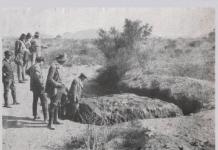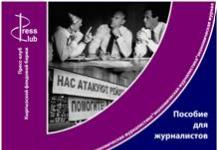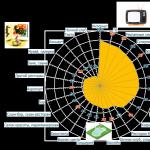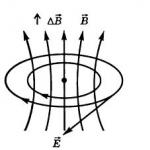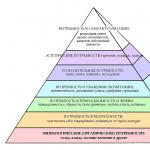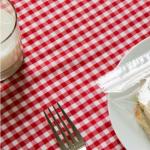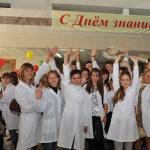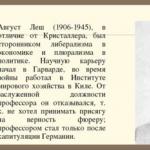Unfortunately, in most cases, a fire does not occur from the moment of the first test heating, as does the lack of oxygen in the house and the presence carbon monoxide it is not felt on the first day - on the contrary, in the first months everything can be fine. But after just a year of active use of a problematic chimney or faulty ventilation ducts, a fire may occur, a disease may develop, or engineering communications they will simply suddenly become completely unusable.
And therefore, it is important not only to know the rules for operating chimneys and ventilation ducts of a residential building, but also to carry out timely inspection and prevention, which is what this article will be about.
You can download the official rules for the operation of chimneys and ventilation ducts in .pdf format:
This short document describes how chimneys and ventilation ducts should be checked in apartment building, and which bodies are involved in this control. But specifically in this article we will pay more attention to the safety of operating chimneys and ventilation ducts of a residential private house or bathhouse, which are rarely discussed, although there is a lot important points. Read the article carefully - you will be surprised!
Any chimney is always the most dangerous source of fire in the house. And all because the temperature flue gases can be prohibitively high. Therefore, even the slightest violation of the chimney installation inside a residential building can lead to dangerous consequences. But it is important not only to install the chimney correctly, it is also important to use and care for it correctly.
What is included in the concept of fire safety?
To begin with, we propose to understand in more detail the concept of fire safety in the operation of a chimney.
Fire safety is the state of an object (and we are talking about a chimney), which is characterized by the ability to quickly prevent the occurrence and development of a fire. Fire safety in the operation of a residential building can be divided into the following: the safety of the floor, ceiling and walls that are nearby, as well as the safety of the chimney itself. This means that the insulation of the room must not only be effective, but also environmentally friendly, so that when heated it does not emit any harmful substances.
In other words, so that it is not a source of the very chemical elements that cause cancer (carcinogens). You can only use natural, safe materials based on stone fibers, fiberglass stone and stainless metal.
Second point: the chimney must be installed and operated correctly:
Controlling the heating temperature of a single- and double-circuit chimney
Fires caused by problems with the chimney often occur due to the combustion of soot, and it ignites from high temperatures. What leads to this? For example, paper and burning plastic produce the highest temperatures, followed by firewood of certain types of wood.
Many people believe that it’s good that if the soot burns out, there will be no need to clean the chimney in the summer, but often it simply destroys the chimney pipe from the inside, which is not prepared for such high temperatures. That is why chimneys, which were initially designed by the manufacturer for low temperature conditions, have the least service life and are more fire unsafe, while the combustion temperature of their firewood is high. Let's compare different breeds wood according to its ability to burn hot in a stove:
- Pine – 624°C;
- Hornbeam – 1022°C;
- Poplar – 468°С;
- Oak – 840-900°C;
- Aspen – 612°C;
- Larch – 865°С;
- Ash, beech – 1044°C;
- Birch – 816°C;
- Alder – 552°С;
- Acacia – 708°C.
Impressive? That's why, in addition to compliance general rules, you always need to take care that the outer contour of the chimney cannot heat up more than the metal from which it is made is designed:

For example, most common reason fires in private houses and bathhouses - this is a 0.5 mm stainless steel chimney, which is placed on wood stoves, although it was originally intended only for gas ones. Unfortunately, at first glance, it is difficult to distinguish a gas chimney from a wood-burning one. You just need to read the label on the pipe and consult the seller.
But this is only one of two factors. The degree of heating of the external circuit also depends on what kind of heater was used. internal insulation and what is its thickness:

Correct design and functioning of a residential chimney
One of the most important rules for ensuring the fire safety of the chimney of a private house is the thermal insulation of the chimney and correct device its designs.
Please also note that from the outer surface of such pipes to the sheathing and roof rafters there should be a distance that corresponds to that prescribed in modern SNIPs 2.04.05-91:
- For concrete and brick pipes this is 130 mm;
- For ordinary ceramic ones (without additional thermal insulation) this is 250 meters;
- For pipes in which insulation is present, this is also 130 mm;
- For pipes assembled with a stainless steel sandwich module, this is a distance of 150-160 from the internal walls of the pipe (according to European standards)
Let's move on. Where the roof and ceiling come into contact with the chimney, the units must be made of non-combustible materials. These are mineral wool, metal plates, special processing for wood with fire-bioprotective mastic and other materials that are replete with modern hardware stores.
It is especially important to take care of the fire safety of the pre-furnace area, if there is one - it is also made of non-combustible materials if it is made. Then you need to purchase ceramic tiles, metal sheets or stone slabs. It’s good if you additionally build a half-brick partition near the wall where the stove or fireplace is placed.
So, safe operation of a chimney in a private house implies:
- The chimney should be installed by a professional or, at a minimum, inspected by him upon completion of installation.
- Most of the chimney modules must be made of 400 series stainless steel, with a thickness of at least 0.8 mm, and the remaining parts are allowed from 300 stainless steel, but with a thickness of at least 1 mm.
- A stove, fireplace or boiler is heated with the type of wood for which it is designed.
And this is just the beginning! The chimney must be monitored, cleaned and protected throughout the entire period of its operation.
Self-inspection of a residential chimney
So, when inspecting it yourself, first check the chimney for cracks. Initially modules metal chimney should not only be connected to each other, but also coated at the seams with silicone sealant.
If we are talking about a brick chimney, smoke should not leak out anywhere at all. If it does leak, this is evidence that oxygen is being sucked into the chimney itself somewhere and reacting with gases. In such a chimney, with just one spark, a fire can easily form. But even a sandwich module burns out from the inside and causes a fire.
Therefore, every year, step by step, you need to check your chimney for problems that may initially be invisible to the eye:


Pay special attention to this point: are there any white plaque? Firing a fireplace or stove with damp wood can lead to the formation of a white crust of wet soot on the walls of the chimney due to moisture, and a regular brush will not help - you need a special scraper. And this is a more complex cleaning technology, because in this case it is easy to damage the surface of the chimney from the inside and give rise to corrosion. Therefore, if you have to resort to such a procedure, purchase a good brush from modern manufacturers that are designed specifically for chimneys.
As you may have guessed, the most difficult situation is with a brick chimney. If a metal pipe was not specifically inserted into it to protect its walls from corroding soot, then you will have to tinker with it a lot. Inspect such a chimney carefully: if you see a blockage of fragments of bricks, then the chimney itself is already collapsing from the inside and is necessary urgent repairs. Namely, pipe insertion - sleeving. If this is not done in time, the brickwork risks collapsing at any moment.
For lining, part of the chimney is dismantled and a pipe is inserted, then a new brickwork is made. Naturally, all this can only be organized in warm time years when the oven does not work. But, in principle, the design itself, when a brick chimney accommodates an additional stainless steel pipe, is one of the most reliable.
But you still need to inspect, clean and prevent such a chimney every six months. If you suspect that the chimney may be problematic or you do not have the most firewood best quality, then what kind of prevention should be done once every two months or even more often. And keep in mind that firewood from spruce and pine has a large amount of resins and is especially harmful to pipes - it is better to avoid them altogether.
Regular cleaning of the chimney to remove soot and internal blockages
And now for some fun physics. When wood burns, white, translucent smoke is formed from wood (after all, there is water vapor in wood), and the smoke becomes black if finely dispersed carbon - soot - rises into the chimney.
At the end of the combustion, only coals and ashes remain that do not burn open flame, but only smolder and react with atmospheric oxygen and also release carbon dioxide and water vapor. It is the creosote released at this moment that poses the greatest danger to the chimney, because the water vapor that comes from the wood at this moment glues such particles and they settle not only on the walls of the chimney, but also on the parts of the heating device. And they form resinous deposits!
Let's talk about soot in the chimney (believe me, it's more serious than you think). It appears when the fuel does not burn completely. And this depends on its type, quality, incoming air and combustion temperature.
The soot itself happens dusty, glossy and even porous.
- For fire dusty Just one spark is enough. This soot creates a porous substance on the walls of the chimney, consisting of ash and a small amount of coal. Even with a sharp increase in draft or ignition of paper, dusty soot can ignite and the flame can reach the top chimney. Such a fire usually leads to overheating and cracks in the pipe, but the sparks that fly out of the chimney are also dangerous (especially when the weather is windy and hot).
- But the fire glossy soot leads to critical temperatures on the chimney walls. Such soot creates a dense, flammable layer and, when burned, can even reach 1000 degrees Celsius. This is an overload on the chimney, and if it is old or cracked, it simply risks not being able to withstand it. In this case, the combustion of such soot can be either fast or slow. With fast combustion, the upper temperature, in principle, does not have time to reach its maximum value, but slow combustion can last up to several hours or heat the pipe walls so much that cracks begin to appear. Slow combustion of glossy is the most dangerous, because it is accompanied by strong gas formation, and clouds of smoke create entire plugs in the pipe.
- Porous soot is not as dangerous as glossy soot, although its structure is similar to it. This layer forms on the walls of the chimney when too hot flue gases enter the chimney. But everything is also susceptible to sudden fire.
All this greatly reduces the efficiency of the chimney, accelerates its wear and even provokes corrosion, and especially advanced cases there is a real fire. That's why it's useful to put a chemical soot remover along with your firewood from time to time. It is made in different formats and different contents, but usually from a mixture of special crystals, which act as catalysts during the combustion process, destroying the structure of resinous deposits. After which, only a fragile husk of soot remains on the walls of the chimney, and it, in turn, easily splits, burns and falls off.
This is why it is so important to seriously select a reliable chimney pipe from the very beginning, because manufacturers specifically indicate resistance to soot fire in the data sheet for this purpose. Therefore, if you have the opportunity now to purchase another chimney (if you have doubts about the old one), which will withstand the necessary loads and even more. After all, there is a huge difference in whether you light a fireplace or stove more for a decorative effect or rare cooking (for example, the stove is in a barbecue gazebo, or this stove will heat your entire house). If you ignore at least one of the manufacturer’s requirements, then nothing good will end, believe me.
If you are wondering where condensation can come from in a chimney, we will explain in more detail. Moisture itself is always in the air, in any room - just in different quantities. It is not noticeable to the eye, because... is in the state of finely dispersed drops. There are more of them in a residential building than, say, in a workshop or attic.
And it is the moisture that enters the stove and chimney with the air, and in the cold part of it it condenses, settling on the pipes in the form of drops. And such condensation is bad not only for the chimney, as it corrodes it from the inside, but also in the sense that it allows soot to simply stick to the walls. As a result, due to condensation, draft is disrupted, because the passage for air becomes less and less. Finally, the moisture reacts with the soot to form a particularly aggressive acid that gradually destroys the metal. The modern sandwich chimney has the least problems with all this, although it must be protected from damp firewood.
Ventilation ducts: ensuring air flow
In addition, unfortunately, modern building materials and furniture in most cases do not have high environmental performance. And all these harmful substances are released into the air. Of course, if there is only one such source of carcinogenic substances in a residential building, then it in itself is not dangerous (its influence is insignificant and the human body more or less eliminates all toxins received during the day) and the manufacturer is absolutely clean before the law.
But there is such a thing as cumulative correlation, which takes into account that a person will breathe harmful elements not only today, but also tomorrow. And if he has certain health and metabolic problems, then a toxic plastic shelf or wallpaper will still be harmful. And this does not take into account the fact that the average person is surrounded by such household items and things in far more than one quantity.
From the current situation there is a simple and affordable solution – high-quality ventilation. Constant influx fresh air and the removal of old air can easily remove all the inhabitants of the periodic table penetrating into the air and thus reducing the mentioned negative impact to almost zero.
For quite a long time in Russia there was a practice of organizing the flow of fresh air into the room due to leaks in the building structures. Simply put, old wooden windows perfectly ventilated the room, but modern double-glazed windows, unfortunately, completely seal it. It’s good if you can set the window of a double-glazed window to micro-ventilation mode or open it completely, but sometimes in winter they forget about this or simply save on heating.
In this case, it is imperative to install coercive system ventilation, which will supply fresh, cleaner and heated air to the room. Or you can also resort to such a makeshift method as a through hole under the window sill frame (preferably above the heating convector). To do this, a small hole is punched, and air comes from it directly from the street. If necessary, use an adjustable damper. Thus, the air is also heated.
In addition to ensuring a healthy microclimate in the living space, ventilation is necessary for the normal functioning of any fireplace or stove. For this purpose, they provide for the organization of air flow, calculating it at 200-300 square meters per hour, if the firebox closed type, and 800-1000 square meters per hour if it is open.
And, finally, watch a short news story about how important it is to monitor the normal functioning of chimneys and ventilation ducts, and how to notice the first signs of problems:
Be careful and take care of your own health and life!
SNiP III-G.11-62
BUILDING CODES AND RULES
HEATING STOVES, SMOKE AND VENTILATION CHANNELS OF RESIDENTIAL AND PUBLIC BUILDINGS. RULES FOR PRODUCTION AND ACCEPTANCE OF WORK
Part III, section D
Chapter 11
Date of introduction 1963-04-01
INTRODUCED by the USSR Academy of Construction and Architecture
APPROVED by the State Committee of the USSR Council of Ministers for Construction on December 14, 1962.
IN REPLACEMENT of Chapter III-B.3 SNiP edition of 1955
Chapter SNiP III-G.11-62 "Heating stoves, smoke and ventilation ducts residential and public buildings. Rules for the production and acceptance of work" was developed by the Research Institute for Construction of AS&A of the USSR in Rostov-on-Don.
With the entry into force of Chapter SNiP III-G.11-62 "Heating furnaces, smoke and ventilation ducts of residential and public buildings. Rules for the production and acceptance of work" loses force from April 1, 1963: § 4 "Furnace work" of Chapter III- B.3 “Stone and stove works” SNiP edition 1955; § 3 “Kiln works” of “Technical conditions for the production and acceptance of stone and kiln works” (SN 46-59); GOST 4058-48 "Stove heating. Fire prevention."
1. GENERAL INSTRUCTIONS
1. GENERAL INSTRUCTIONS
1.1. The rules of this chapter apply to the production and acceptance of work on the installation of furnaces with fire furnaces: heating, heating-cooking, kitchen stoves etc., as well as smoke and ventilation ducts in the construction of residential and public buildings.
Notes:
1. Factory production furnaces, blocks and metal parts for them and for chimneys are not covered by this chapter.
2. Rules regarding application gas fuel in stoves, cookers and other household appliances, are given in chapter SNiP III-G.2-62 “Gas supply. Internal devices. Rules for production and acceptance of work."
1.2. The placement of stoves, stoves, chimneys and similar devices in the building plan must be carried out in accordance with the architectural and construction project, and their laying - according to standard or working drawings included in the project.
The construction of stoves, stoves, etc. without the appropriate drawings is not permitted.
When carrying out furnace work, no deviations from fire safety requirements are allowed.
1.3. The laying of stoves must be carried out by stove makers who have a certificate issued by the departmental qualification commission for the right to carry out stove work.
1.4. Furnace work should be carried out according to the work project using advanced labor methods, rational tools, equipment and devices.
2. CONSTRUCTION MATERIALS FOR FURNACE WORK
2.1. Materials for furnace work must meet the requirements current GOSTs and project guidelines.
2.2. The same materials are used for laying foundations for furnaces and chimneys as for building foundations.
2.3. For stoves, stoves, chimneys, and ducts made of brick, the following materials should be used:
a) for the main masonry of stoves, chimneys and smoke channels in the walls, including gas appliances, there is ordinary clay brick (solid);
b) for lining - refractory and refractory bricks;
c) for cladding - tiles, roofing and rolled steel, asbestos plywood;
d) for cutting fire retardant insulation and cladding - ordinary clay brick (solid), asbestos cardboard, asbestos-cement thermal insulation boards, inorganic mineral wool products on a synthetic basis (mats, semi-rigid boards), construction felt soaked in clay mortar.
Note. The use of mineral wool products with a bitumen binder for fire retardant insulation is not allowed.
2.4. When performing furnace work, the following solutions should be used:
a) for laying stoves and kitchen stoves from ordinary bricks - clay-sand;
b) for masonry made of refractory brick - refractory clay with sand;
c) for masonry made of refractory bricks - refractory clay with fireclay powder;
d) for laying chimneys, ventilation and smoke ducts in the walls of buildings - lime-sand or lime-cement;
e) for laying chimneys above the attic floor - lime-cement, and above the roof - cement.
2.5. The composition of the clay-sand mortar is determined depending on the fat content of the clay in ratios that ensure drying of the solution without a noticeable change in volume and without cracking.
The preparation of the clay-sand mortar should be done in advance, at least one day before the start of work.
2.6. The following special requirements apply to materials for furnace work:
a) the brick must have the correct shape, be the same size, not contain foreign inclusions, produce a clear sound when tapped, and be strong enough;
b) clay for laying ordinary bricks should be plastic, predominantly red, not contaminated with random impurities; Before use in the solution, the clay must be soaked and rubbed through a mesh with 3-4 mm holes;
c) sand for solutions should be used predominantly from mountains, without foreign impurities and plant residues, fine-grained, sifted through a sieve with cells of 1-1.5 mm;
d) to prepare solutions you should take clean water; in case of use sea water the norms of cement in solutions should be increased by 10-15%.
3. PRODUCTION OF FURNACE WORKS
3.1. Mass production of industrial-type stoves and cookers, as well as blocks, frames and other elements for them, as a rule, should be carried out in factories using special technology with random testing of products regarding their strength and heat resistance.
In the case of production of the same products under conditions construction site special attention should be given to the choice of concrete composition and other means that ensure heat resistance of the blocks.
3.2. When receiving stoves and stove blocks from the manufacturer, each set and the accuracy of the dimensions of the individual blocks should be checked before installation and assembly.
All furnace devices - doors, valves, etc. - must be in good working order and firmly strengthened.
3.3. Assembly and reinstallation of factory-made stoves and cookers must be carried out in accordance with the instructions of the manufacturer.
If individual stove blocks weigh more than 50 kg, the stoves should be assembled using the simplest mechanisms.
Clay mortar should be used for laying blocks, brick liners and linings.
3.4. Furnace work should be carried out only if there is a permanent roof or temporary shelter over the place where the furnaces are laid.
3.5. Procurement and delivery to the site of materials and products for the production of furnace work (furnace blocks, bricks, clay, sand, metal parts, furnace equipment, etc.) should be carried out in advance and in quantities that ensure the uninterrupted operation of these works.
3.6. Materials intended for laying stoves must be reliably protected from precipitation, and in winter conditions immediately before use, heated to a temperature not lower than +5 °C.
3.7. Furnace work should be started with the appropriate technical documentation:
a) building plans with reference to furnaces, chimneys and foundations for them;
b) standard or working drawings of furnaces with orders.
3.8. Laying foundations for furnaces and chimneys must be carried out in accordance with the rules given in chapter SNiP III-B.4-62 "Masonry structures. Rules for production and acceptance of work." It is recommended to use concrete blocks for foundation construction.
Gaps should be left between the foundations for stoves and pipes and the foundations of the building walls and filled with sand.
3.9. The laying of the foundation for the stove and chimney is not brought to the level of the finished floor by 15 cm. On top of this masonry, a lining is made of two rows of bricks with a layer of waterproofing laid between them (2 layers of roofing felt or roofing felt).
3.10. Ordinary clay bricks must be moistened with water before laying them.
Refractory and fire-resistant bricks and ceramic products only need to be rinsed with water.
3.11. The laying of stoves, stoves and chimneys should be carried out in compliance with the horizontal rows, plumbness, correctness of external surfaces and angles, as well as the proper shape and size of internal channels, guided by the procedures shown in the drawings.
3.12. Each row of masonry must be laid with the seams tied into bricks. In rows where the use of three-quarter bricks is necessary to ensure ligation, ligation in bricks is allowed. Bandaging the seams of the main masonry with a lining made of refractory or refractory bricks is not allowed.
3.13. The thickness of the seams of stove masonry made from ordinary clay bricks should be no more than 5 mm, and from refractory and refractory bricks - 3 mm.
The thickness of the seams of pipe laying made with lime or complex mortar is allowed 10 mm.
Horizontal and vertical joints must be filled with mortar to the full thickness of the wall.
3.14. The stove can rest directly on the ceiling if it is specially designed for the static load from it and the fire safety requirements of Section 5 of these standards are met.
3.15. As the masonry is erected, the internal surfaces of the stoves and channels must be mopped with a wet cloth without using a solution.
3.16. Small openings in the walls of furnaces should be covered with bricks or brickwork, and larger ones should be covered with arches. The use of steel lintels to cover holes is not permitted.
Small spaces in the kilns are covered with brick overlaps, and large spaces with vaults.
The laying of the vaults should be carried out with bandaging of the rows so that there are no through vertical seams.
3.17. Fastening the frames of fireboxes and other doors in the brickwork is done using claws made of steel tape. The tabs riveted to the doors are laid and secured in the masonry seams. The doors are installed in place simultaneously with the laying of the stove; At the same time, asbestos is laid around the perimeter of the frame.
3.18. The grates are located in the firebox 7-14 cm below the combustion hole and laid in place, leaving 5 mm wide gaps around the perimeter, filled with sand. The slots in the grate should be directed along the firebox.
3.19. Smoke valves or views are installed in the furnace or in the smoke duct according to the drawing.
If the fuel for the stove is coal or gas, then a 20 mm hole must be drilled in the valve or view.
3.20. As the furnace is being built, an intermediate check should be made for the correct laying of the firebox, gas ducts, the strength of the fixtures, etc.
On hidden work an act must be drawn up signed by the work manufacturer and the stove maker.
3.21. The lining of stoves and cookers is determined by the project.
At external design and when finishing stoves and stoves, it is necessary to ensure that all external surfaces look smooth and can be kept clean.
3.22. Tile tiling is carried out simultaneously with the execution of brickwork, with fastening the tiles to each other and to the masonry using staples, pins and wire.
Cladding with tiles can be done in two ways: “in a straight thread,” when the vertical seams coincide and serve as a continuation of one another, or tied onto the tile in each row.
The tiles are pre-selected dry on the floor according to size and shade, and then they are hemmed and ground in.
Vertical seams between tiles should be made flush, and horizontal seams should be 1.5 mm thick and filled with gypsum mortar.
When installing tiles, you must strictly observe the horizontality of the rows and the plumbness of the planes and angles.
3.23. Cladding of stoves and cookers in metal frames can be made with asbestos plywood or glazed tiles.
Sheets of asbestos plywood are laid between the posts and braces of the frame and pressed against the inside with brickwork.
When tiling, sticking them onto the finished surfaces of the stove is done using one of the following solutions:
a) liquid glass, b) liquid glass with cement, c) liquid glass with finely ground quartz sand and 2% sodium fluoride.
3.24. Plaster brick kilns and pipes, depending on the required quality of finishing, purpose and humidity of the room, is produced with solutions: a) clay-sand, b) lime-clay-sand, c) lime-alabaster-sand and d) cement-clay-sand. The thickness of the plaster sheet should not exceed 10 mm.
Notes:
1. Cement-clay-sand mortar is used in rooms with high humidity.
2. To give the plaster greater strength, asbestos fiber is added to the solution (0.1-0.2 parts by volume). Plastering the walls of ovens should be done after they have dried.
3.25. The simplest finishing of the external surfaces of furnaces is done by mopping the walls and grouting them with dry brick or jointing the masonry joints.
Furnaces are painted with water or casein paints, as well as with lime.
Furnace appliances and metal cases painted with oven varnish or heat-resistant paints.
The surfaces of chimneys in attic spaces should be mortared and whitewashed, and above the roof - finished according to the instructions in the project.
3.26. When installing kitchen stoves and other fireplaces, the following work must be performed:
a) along the perimeter of the top of apartment-type slabs, a frame of corner steel is laid, and for slabs with heavy duty use (for example, in dining rooms), they are additionally reinforced at the corners with racks and are equipped with a safety handrail on top;
b) top surface the oven is protected from excessive heating by a layer of clay with crushed stone or flake;
c) the installation of a combined kitchen stove with a hot water boiler for residential heating should only be carried out according to a special drawing of the heating project.
3.27. Drying of stoves is carried out by heating them with gradually increasing portions of fuel (dry shavings, wood chips, firewood), starting with a filling of 20-30% of the usual norm. The drying time is set depending on the size of the oven and the degree of moisture in the masonry. Drying can be considered complete if damp spots no longer appear on the surface of the oven, and there are no traces of condensation on the valve or view.
While drying the furnace, the valve, furnace and blower doors, as well as the window vent should remain open around the clock. The temperature of the outer surfaces of the oven during drying should not exceed 50-60 °C.
3.28. When carrying out furnace work in winter conditions, the following rules must be observed:
a) laying foundations for furnaces should be done in heated rooms or by freezing; in the latter case - with mandatory thawing and hardening of the solution before laying the stoves;
b) it is allowed to lay stoves in portable heated greenhouses;
in both cases, the room temperature during laying and until the oven is completely dry should not be lower than +5 °C. The laying of stoves and kitchen stoves on consoles embedded in the walls of a building constructed using the freezing method can be allowed no earlier than the complete hardening of the thawed brickwork mortar;
c) laying stoves using the freezing method is not allowed;
d) bricks used for laying stoves in greenhouses must be heated, sand and clay must be thawed, and water must be heated to +12-15 °C;
e) main pipes and channels may be laid using the freezing method in compliance with general construction rules;
e) stoves stored in heated rooms must be dried before they are exposed to freezing temperatures.
4. SMOKE AND VENTILATION CHANNELS
4.1. Each stove and cooker must have a separate smoke duct in a root or cap pipe or in a stone wall with a direct outlet above the roof.
In exceptional cases, it is allowed to connect two fireplaces to one smoke duct, located on the same floor and in the same apartment, and the entries into the duct must be at a distance of at least 0.75 m from each other along the height of the duct. When the inputs are located at the same level, the smoke channel is cut by a brick partition into two channels to a height of at least 0.75 m from the level of the inputs.
4.2. To remove combustion products from gas appliances (water heaters, etc.), it is necessary to install separate smoke channels with dense walls. The cross-section of the smoke ducts should be made according to the design.
4.3. Smoke and ventilation ducts in brickwork must be made strictly vertically with partitions between them no smaller than bricks and the joints must be completely filled with mortar.
If necessary, it is allowed to make a channel in the wall at an angle of up to 30° to the vertical with a distance of no more than 1 m. Throughout the inclined section, its normal cross-section must be maintained.
4.4. The installation of smoke and ventilation ducts in the external walls of a building is not permitted. In exceptional cases, such placement of smoke ducts is permitted provided that they are insulated on the outside of the wall by thickening the masonry or in another way provided for in the project.
4.5. If the walls of the building are made of slag concrete stones, slotted or sand-lime bricks, the laying of wall sections with smoke channels should be made of ordinary solid clay bricks or the channels can be made of ceramic pipes or special heat-resistant blocks.
4.6. The height of the chimneys above the roof of the building is set by the project depending on their horizontal distance from the ridge. In all cases, this height must be at least 0.5 m from the roof, and overall height smoke channel from the level of the grate - at least 5 m.
Note. If there are no instructions in the project, the height of the pipe should be:
a) at least 0.5 m above the ridge, if the pipe is located at a distance of up to 1.5 m from the ridge;
b) not lower than the level of the ridge, if the pipe is located at a distance from 1.5 to 3 m from the ridge;
c) not lower than a line drawn from the ridge downwards at an angle of 10° to the horizontal, if the pipe is located more than 3 m from the ridge.
4.7. The tops of chimneys and brick walls with channels must be protected from the effects of precipitation by plastering them cement mortar. Chimneys and ducts in walls should not be blocked with metal umbrellas.
4.8. Exiting ventilation ducts located next to smoke ducts above the roof should be done at one general level.
4.9. In the flue ducts of furnaces and smoke ducts, in places where soot and ash carryover may accumulate (with the exception of attic spaces), cleaning holes must be installed, closed with doors sealed with bricks on the edge with clay mortar.
5. FIRE FIGHTING MEASURES
5.1. In places where combustible parts of the building (floors, beams, etc.) are adjacent to smoke ducts, it is necessary to arrange cuttings, i.e. thickenings in the brickwork of pipes and walls with smoke ducts. Cuttings should also be arranged in places where combustible structures approach ventilation ducts, if the ventilation ducts are located next to smoke ducts.
5.2. The cuts at chimneys and walls with smoke ducts in the ceilings must be no less than those indicated in Table 1.
Table 1
Name of furnace devices | Distances in cm from the inner surface of the smoke channel to the combustible structure (cutting) |
||
the structure is not protected from fire | the structure is protected from fire |
||
Heating furnaces of intermittent operation with combustion duration: | |||
a) up to 3 hours | |||
b) more than 3 hours | |||
Gas-heated furnaces with a gas flow rate of more than 2 m3/h | |||
Residential kitchen stoves running on solid fuel | |||
Residential gas water heaters | |||
Kitchen stoves in enterprises catering and in dormitories | |||
Combination stoves with built-in boilers and separate boilers for residential heating | |||
Notes: |
|||
5.3. When installing grooves in the ceiling, independent settlement of the furnaces and pipes should be ensured. Therefore, cuttings should not be allowed to rest on structural elements ceilings The cutting height should be greater than the thickness of the ceiling by the amount of possible settlement of the building and 7 cm above the layer of combustible backfill. Horizontal cuts in the plane of the floors are carried out simultaneously with the main masonry.
5.4. The gaps between the ceiling and the groove are filled with clay mortar mixed with asbestos fines.
5.5. The ceiling lining and floor should only be finished before cutting. The floor above the horizontal cutting must be made of fireproof materials (concrete, tiles).
5.6. Metal and reinforced concrete beams, passing near chimneys, must be at a distance of at least 13 cm from the inner surface of the latter.
5.7. Between the stove and the chimney, on the one hand, and the combustible wall or partition, on the other hand, an air gap (recess) must be left for the entire height of the stove or chimney.
Combustible walls or partitions in retreats must be protected with thermal insulation materials.
The width of the setback and the method of insulating walls and partitions in the setbacks are taken in accordance with Table 2.
Table 2
Name of heating stoves | Type of derogation | Distance between the stove and the combustible wall or partition in cm | Methods for protecting combustible structures |
|
Apartment-type stoves with brick-thick walls with a combustion duration of up to 3 hours | Open or closed on one side | Lime or lime-cement plaster 25 mm thick. Asbestos-vermiculite slabs with a thickness of at least 25 mm. Asbestos cardboard and others |
||
Closed on both sides | Brick cladding in bricks with clay mortar or asbestos-vermiculite slabs - 40 mm and others |
|||
The same, with brick-thick walls | Open on both sides | Lime-gypsum plaster - 25 mm. Asbestos-vermiculite slabs - 40 mm and others |
||
Concrete ovens with a wall thickness of 4-6 cm | ||||
Long-burning heating stoves | Open | |||
Stoves and stoves with brick walls with a fire duration of more than 3 hours | Open | The same, or brick cladding with clay mortar |
||
Closed | Brick cladding in bricks |
|||
Metal furnaces without lining | Open | Plaster 25 mm |
||
Same with lining | ||||
Notes: |
||||
5.8. In public canteens, children's and medical institutions, and dormitories, insulation of combustible walls and partitions near kitchen stoves is done according to clause 7 of Table 2.
5.9. The air gap (recess) near the stoves can be left open or sealed on both sides with brick walls or other fireproof materials.
The floor in the air gap should be covered with bricks one row above the floor level of the room. The side walls of the closed chamber should not be tied to the main masonry of the furnace. Openings should be left at the top and bottom of the walls, covered with gratings with a clear cross-sectional area of at least 150 cm each.
Note. In children's and medical institutions, it is not allowed to leave open air gaps near stoves.
5.10. Vertical cuts in the openings of combustible partitions should be made to the entire height of the furnace or pipe, their thickness should be no less than the thickness of the partition. The cutting width must be carried out in accordance with Table 1.
5.11. The distance from the upper plane of the stove ceiling to the combustible and fire-protected ceiling of the room must be no less than that indicated in Table 3.
Table 3
Type of stoves | Distance from the top of the stove ceiling to the combustible ceiling in cm |
|
the ceiling is not protected from fire | the ceiling is protected from fire |
|
Heat-intensive furnaces | ||
Non-heat-intensive stoves | ||
Notes: |
||
5.12. When laying thick-walled stoves and apartment-type kitchen stoves, the following minimum distances from the floor level to the bottom of the gas circuits and ash pan must be observed:
a) with a combustible base:
to the bottom of the ash pan - 14 cm, to the bottom of the gas circulation - 21 cm;
b) with a fireproof base and a combustible floor:
the bottom of the ash pan is at floor level, to the bottom of the latter; gas turnover - 14 cm; to the bottom of the remaining gas circulation - 21 cm;
c) with a fireproof base and fireproof floor, the bottom of the ash pit and all gas ducts can begin to be laid out from the floor level of the room.
5.13. Combustible floor under frame thin-walled stoves and cookers with metal legs must be insulated with 12 mm thick asbestos cardboard and covered with roofing steel on top.
5.14. Installation of kitchen stoves restaurant type without legs is allowed only on a fireproof base.
5.15. To protect the floor and wall near the furnace door from fire, you must:
a) nail it on the wooden floor in front of the fire door metal sheet 70x50 cm in size, covering the area of the floor and baseboard near the stove wall;
b) protect the combustible wall adjacent to the front of the furnace at an angle near the combustion door from fire;
c) the distance from the combustion door to the opposite wall must be at least 1.25 m.
Note. In children's and medical institutions, combustion openings in heating stoves should be located on the side of the corridors.
5.16. The gap between the top of a thick-walled stove and the ceiling can be closed on all sides with brick walls; in this case, the thickness of the upper ceiling (roof) of the stove must be at least 4 rows of brickwork, and the combustible ceiling is protected from fire.
5.17. It is not allowed to place wooden beams in the brickwork between the stoves of the lower and upper floors.
5.18. When passing through the roofs of brick and concrete pipes and walls with smoke ducts, their internal surfaces must be removed from combustible structures (rafters, mauerlats, sheathing, etc.) no less than indicated for the corresponding case in Table 1. In this case, the outer surfaces of pipes and walls with channels must be at least 13 cm away from the same structures.
The free space between the pipes and combustible structures must be covered with fireproof roofing material, with it placed under the pipe.
5.19. Metal chimneys must be 70 cm away from combustible roof structures. At the same time, within the attic, pipes must be insulated with a layer of asbestos at least 3 cm thick and plastered over a mesh with cement mortar, and in places where they pass through a combustible roof, they must be additionally equipped with special devices in the form sandboxes
5.20. Chimneys of buildings with combustible roofs must be equipped with spark arresters (metal mesh) with holes no larger than 5 mm.
5.21. In attics, horizontal smoke ducts and cleaning holes on chimneys are not allowed.
5.22. For connecting furnaces to smoke ducts in main pipes and in stone walls Nozzles and transfer hoses (horizontal chimneys) can be used, subject to the distances specified in Table 1 and the following rules:
a) the length of the transfer hoses should not exceed 2 m,
b) thickness brick walls and the bottom of the reversible sleeve, enclosed in a case made of roofing steel, must be no less than a brick, and in the absence of a case - no less than a brick with clay-sand mortar.
The thickness of the sleeve roof must be at least two rows of brickwork with bandaged seams;
c) short metal pipes with a length of no more than 40 cm made of sheet steel with a thickness of at least 1 mm can be used without lining, but with the application of 3 cm of asbestos insulation and plaster over a metal mesh;
d) for transfer hoses, reinforced heat-resistant concrete pipes and rectangular boxes can be used, as well as pressure asbestos-cement pipes without joints along the length of the hose, insulated with a 3 cm thick layer of asbestos, plastered over a metal mesh;
e) reversible sleeves must be reliably strengthened by laying them on metal or concrete beams;
f) hoses should be laid with a rise of 0.01 in the direction of smoke movement;
g) the installation of detachable hoses and pipes is prohibited;
h) the outer surface of the bottom of the transfer hose or pipe located above the combustible floor must be at least 14 cm away from the latter.
5.23. In seismic areas, the installation of mounted chimneys on stoves is not allowed, and the stoves themselves must be enclosed in frames made of angles or in cases made of roofing steel.
5.24. Installation ventilation grilles on smoke ducts is not allowed.
5.25. Drying and test firing of stoves before the chimneys are installed above the roof are not permitted.
6. ACCEPTANCE OF FURNACE WORK
6.1. Handover and acceptance of furnace work when it is carried out en masse is as follows: technical examination and inspection of all stove devices without exception in each apartment or other facility. At the same time, compliance with the project and the number of completed stove devices, the quality of work in terms of fireboxes and gas ducts, the quality and durability of the installation of stove devices, external finishing, the presence of cleaning and compliance with all fire safety rules must be checked. For hidden work (gas ducts, cutting, insulation, etc.) the corresponding certificates must be presented.
6.2. The density of the walls of chimneys and smoke ducts must ensure that smoke and gas combustion products do not penetrate into adjacent rooms, as well as into ventilation ducts.
6.3. Deviations of the surface of the furnace masonry from the vertical should not exceed 2 mm per 1 m of height. Irregularities on the surface are allowed no more than 5 mm for stoves and pipes without lining and 2 mm for stoves lined with tiles.
Deviations from the accepted dimensions in terms of a stove, kitchen fireplace or chimney should not exceed ±0.4%.
6.4. During the test fire, draft, tightness of closing valves or views, heating of all walls of the oven, oven, frying plate, etc. should be checked. A test fire is carried out after the stove has dried.
6.5. In case of detection of defects that prevent normal and safe operation furnaces, a defective list is drawn up and a deadline for their elimination is assigned. Operation of the furnace cannot be permitted until the defects are completely eliminated.
Electronic document text
prepared by Kodeks JSC and verified against:
official publication
M.: State Publishing House
literature on construction,
architecture and building materials, 1963
In order for your boiler to serve you correctly and for a long time, you need to regularly clean not only the chimney, but also the gas channels.
Fire requirements for the cleaning process
Building codes and regulations regulate the process of cleaning chimneys and ventilation ducts as follows:

- First of all, cleaning is carried out before the start of the heating season. This applies to those chimneys that operate seasonally.
- The cleaning process for combined and brick chimneys must be carried out at least once a quarter.
- As for asbestos-cement chimneys and channels made of heat-resistant concrete, the recommended period for regular cleaning is once a year.
The initial check includes:
- Checking for proper use of all chimney materials in accordance with relevant requirements.
- Detection of blockages in channels.
- Study of partitions providing protection to combustible structures.
- Distance from ventilation and smoke ducts and compliance with the standard.
- Correct operation and position of the head.
- Careful draft measurement.
Re-checking is carried out on the following points.
1) Ventilation and chimney are examined for blockages, and if any are identified, their density and draft are examined.
2) The post-repair inspection for the first time after the relevant work is carried out by service specialists together with the operating company. The results obtained are recorded in a special act.
3) If a chimney or ventilation duct is found to be unsuitable for use, the inspection expert must notify the owner in writing.
4) In private houses where a SNIP chimney is installed, it is possible to independently clean the channels and the chimney itself upon receipt of a document confirming the completed instruction.
5) If the operating organization apartment building plans to begin any repair work regarding chimneys and ventilation, it must first notify residents of these measures. Naturally, after all this work has been carried out, the system undergoes a thorough check.
Requirements for rooms in which gas appliances are located
Each chimney must comply with certain standards, which are divided by type of premises.
- SNiP 31-01-2003 – provisions on multi-apartment residential buildings
- SNiP 41-01-2003 – general information about ventilation, heating and air conditioning systems
- SNiP 42-01-2002 – instructions on gas distribution systems
- SP 31-106-2002 – provisions on the design and construction of residential single-apartment buildings
- SP 42-101-2003 – standards for construction and design work in the gas distribution system of various pipe inlets
IN general outline, we can highlight several provisions that are mentioned in these resolutions.
- The height of the ceilings in the room in which it is planned to install and place a gas water heater, as well as a chimney, must be at least 2 meters. The volume of this area should not be less than 7.5 cubic meters for one device, and at least 13.5 cubic meters for two.
- The room must be equipped with a high-quality ventilation duct. It is also worth considering the location of the grille or a certain passage between the floor and the door.
- In rooms that have a standard exhaust hood installed, compensation of the removed air occurs due to that which penetrates from the outside and from other rooms.
- In the bathroom as well various rooms Utility doors must open outward.
- Also, installing sockets and switches in the bathroom is strictly prohibited.
Requirements regulating the operation of chimneys.
Installation work related to heating equipment various types, must be carried out strictly in accordance with the rules for installing a chimney.
- It is important to maintain the correct chimney values that meet the standards and requirements of the installed equipment. This is important because it determines further work devices.
- The installation process must be carried out in accordance with all regulations fire safety experts in their field.
- It is best to follow the manufacturer's recommendations.
- The diameter of the design channel should be chosen the same or larger, based on the parameters of the chimney itself.
- According to NPB-98, the speed of flowing air in the channel should be approximately 15-20 meters per second.
Basic rules
Depending on the conditions in which you plan to use the chimney, it can be of different designs. Moreover, the quality of manufacture of this design and the material used directly affects the operation of the chimney and its efficiency. Installation of such products is carried out in accordance with the requirements of the manual DBN V.2.5-20-2001 and SNiP 2.04.05-91. It describes the basic principles of the use and installation of chimneys, and also displays fire safety requirements.
- SNiP 41-01-2003 – basic provisions on air conditioning, ventilation and heating
- NPB 252-98 – devices that process various types fuels for heat generation and their testing
- GOST 9817-95 – technical specifications work with heating equipment
- VDPO - technical work and rules for repair of smoke ducts and furnaces
SNIP chimneys must fully meet the stated requirements. After completion of the test and commissioning, this device receives a special certificate of the test performed.
Rules for installation work
- Exhaust gases must be removed freely from the premises.
- Each appliance must have its own chimney connected.
- The diameter of the chimney should not be less than the outlet of the equipment pipe.
- The thickness of the pipes must be at least 0.5 mm. The material is considered to be alloy steel with increased resistance to corrosion.
- To provide easy access to cleaning the chimney, you need to provide pockets 25 cm deep.
- Smoke channels according to their own design features should not have more than 3 turns, and the radius cannot be less than the diameter of the pipe.
- The minimum height of the chimney should be 5 meters. This is the optimal value to ensure proper traction.
- The distance above the roof of the building should be:
- On a flat roof - up to 500 mm.
- If the pipe is located less than 1.5 m from the ridge - up to 500 mm.
- If the structure is located 1.5-3 m from the ridge - no less than the axis of the ridge.
Installing all elements heating system happens from the bottom up. Installation of several pipes is carried out by inserting one into another. To increase the tightness, suitable sealants are used that can withstand high level temperatures The connecting points must be secured with clamps. To prevent sagging of the structure, you need to carefully connect all elements to the brackets.

Based on the rules for constructing chimneys, we can conclude that smoke ducts are located inside those walls that are made of non-combustible materials. In the event that such structures are not available, it is customary to use crown and sleeve pipes. Speaking about thermal insulation, it is worth noting that this issue should be given special attention. It is important to equip parts of the chimney that pass through unheated rooms, as well as those located outside the building, with appropriate thermal insulation to prevent the formation of condensation.
Following the requirements, you can install the following chimney options.
- Modular type. In this case it is prohibited:
1) Light the boiler with flammable liquids
2) Use firewood larger size than the firebox
3) Dry clothes and other items on the chimney elements
4) Burn off the soot
5) Use the device in an inappropriate manner
6) Put out the fire in the firebox with water
7) Use chlorine for connections
Chimney inspections should only be carried out by specialists. This should be done at least twice during the active heating period to ensure the correct operation of your chimney.
- When connecting two boilers to a chimney, the cross-section of the pipe is determined by their joint operation.
- It is allowed to connect various gas appliances for non-domestic purposes to common chimneys.
- The installation of smoke exhaust pipes can be carried out through one, observing all verified calculations.
- It is possible to release exhaust gas products from several devices at once. In this case, calculations must be made at each level.
- The cross-section of the chimney is determined based on the operation of all operating devices.
That is why all chimneys that meet SNIP work for a long time and with high quality, and also meet legal requirements.
Connecting elements
Installation of these structures requires the use of welding equipment. Control over their work is regulated by SNiP 3.05.03.85 5. Basic provisions:
- Compound gas water heaters, as well as other gas appliances, occurs using pipes, the materials for which are roofing steel.
- The total size of all connected elements should not exceed 3 meters for new buildings and no more than 6 meters for existing ones.
- The slope of the chimney pipe used to the heating equipment should be from 0.01.
- 3 bends are allowed when installing smoke exhaust pipes. In this case, the bending radius should not be less than the diameter of the pipe.
- The joining of pipes must be tight and reliable, and the insertion of one into the other must be at least half of the diameter.
- Speaking about pipes made of black iron, it is worth noting that they require additional painting with fire-resistant varnish.
If the operation of your heating system and chimneys in particular does not meet the above operating requirements, you risk being disconnected from the gas supply by regulatory authorities.
Smoke and ventilation ducts play a role in our homes that cannot be overestimated. Without them, room ventilation and operation become unavailable heating devices. The important thing is that they help maintain health on several levels at once.
What are we talking about? First, constant indoor air circulation is vital to ensure that harmful microorganisms leave the enclosed space before they can cause harm.
Secondly, the dust concentration is reduced, which means that people's breathing will not be difficult.
Thirdly, it reduces the likelihood of property damage.
And fourthly, but not least, in the event of a gas leak or smoke in a fire, ventilation, without exaggeration, saves lives by removing hazardous substances out. Failure of ventilation can cause irreparable damage.
From the examples given, the role of chimneys and ventilation ducts becomes clear. But, like everything in our life, these devices have an unpleasant, albeit natural, property: they work worse if they are left unattended for a long time and not maintained in the required condition. These items need to be checked frequently. If everything comes to such a sad outcome, all that remains is to call specialists who will solve the problem and return everything to normal order.
So who carries out maintenance of ventilation and smoke ducts? By law, only those organizations that meet certain requirements are granted this right. First of all, they must have a special license - inspection organizations involved in monitoring ventilation ducts and chimneys must have such permission. Without it, not a single entrepreneur is worthy of trust, because putting the check in the hands of a non-professional is more expensive for yourself.
That's not all, of course. Even licensed organizations sometimes do not do their best business. This is sad, because such actions should only be carried out by specialists. It's worth checking out reviews of the company to know if they actually deliver on the services they provide.
It is worth talking in more detail about licenses, necessary for specialists. The first of these is the installation permit, maintenance and repair of smoke removal and smoke ventilation systems. It gives the right to inspect ventilation ducts and chimneys. In order to also clean smoke exhaust ducts, a second license is required - “Installation, repair, cladding, thermal insulation and cleaning of stoves, fireplaces, other heat-producing installations and chimneys.” It would be a good idea to make sure your employees have such permissions before entrusting them with your channels.

Fine. Let’s say that the performing company has already been selected, and the customer is completely confident in the quality of the services it provides. When is it worth calling its specialists for periodic inspection? Of course, problems arise in smoke and ventilation ducts, but calling people over trifles (and paying ridiculous money for it) is not worth it. The timing of the test must be chosen wisely.
1.
2.
3.
4.
5.
Poor draft is a problem that owners of their own homes with a fireplace or stove heating, and residents apartment buildings in cities. The latter constantly complain about insufficient ventilation. This happens due to the fact that the maintenance of chimneys and ventilation ducts is carried out irregularly or in bad faith.
The air we breathe has a direct impact on our overall health. The harmful impurities it contains can cause serious harm and lead to dire consequences in the future. Various microorganisms living in homes due to contaminated ventilation ducts cause the development of diseases. Carbon monoxide, which penetrates into the room due to weak draft of chimneys, is a common cause of death.
Therefore, inspection of chimneys and ventilation ducts must be carried out correctly and regularly in order to promptly detect and eliminate faults.
How to operate ventilation ducts and chimneys
You should know the most common causes of malfunctions of ventilation ducts and chimneys. Of course, there are a lot of them, but most are associated with the irresponsibility of the owners.
If supply and exhaust ventilation does not work in the apartment, this may be due to shortcomings in the design of the system. True, sometimes ventilation ducts or chimneys are used by workers during construction as a kind of garbage chute. And clogged channels, naturally, do not fulfill their main task.

Sometimes the system becomes clogged through no fault of the homeowner, for example, when foreign objects such as cobwebs, dust, leaves, or birds accidentally falling into the pipe get into the channel.
Another reason for poor traction is natural deposits of dust, soot and grease on the walls. They can be seen in the photo. must be done immediately. How will such signs appear?
Burning poorly dried or containing large number tar from firewood, as well as household waste. Cleaning of chimneys and ventilation ducts is necessary in these cases.
Quite a lot of poisoning from combustion derivatives and fires is usually associated with the inability of ventilation and chimneys to cope with their immediate functions. That is why requirements and rules for the operation of these systems, as well as pipe and furnace work, were developed. Chimneys and ventilation ducts: basic standards provide the basics of their operation in order to regulate the operation of ventilation, which is important for human health.
According to SNIP, chimneys and ventilation ducts, as well as their inspection, must strictly follow following rules:
- The ducts of stoves and fireplaces that burn wood (solid fuel) must be checked and cleaned before and after the heating season. If the furnace operates continuously, they are inspected every quarter. Inspection of ventilation ducts and chimneys should occur, respectively, every quarter and twice a year (in winter and summer).
- If, during an inspection of chimneys and ventilation ducts, any serious faults that require repair are identified, heating and gas appliances must not be used until the problem is completely eliminated.
- Repair and installation of chimneys and ventilation ducts must be carried out by organizations with the appropriate license. Their workers usually have the necessary skills. They have the right to start work only after drawing up a chimney or ventilation inspection report.

These rules must be observed both by the owners of their own private houses and by the institutions responsible for the maintenance and upkeep of apartments and ventilation systems in them.
In addition to the above generally binding rules, it is advisable to use these recommendations:
- use high-quality and completely dried firewood with a low resin content;
- do not burn household waste in a fireplace or stove, especially bottles and plastic bags;
- clean the vent and firebox from accumulated ash, roof hoods from grease and dust;
- to improve traction in a channel or pipe, as well as forced exhaust buy a hood. This advice will be useful to owners of chimneys with a small internal cross-section;
- A protective mesh cap installed on the chimney prevents entry into the ventilation duct. During the winter months, it is necessary to ensure regular inspection of this part of the system to avoid blockage of the channel and freezing of the tip.
Inspection, repair and cleaning
Options for inspecting ventilation and smoke ducts: you can check ventilation ducts and chimneys as usual, in the classic way- using a brush, a long rope and a weight. True, now for system inspection they almost always use more modern methods. For example, they are used digital photos and filming with a video camera with spotlights.
Instruments have also been developed that allow you to very quickly, without much effort, accurately assess the draft in a chimney or ventilation.

Based on the results of the inspection, an inspection report of the channels (chimneys) is drawn up, which is drawn up in the form of a technical report of a clearly established form, after which a conclusion is issued containing recommendations for installation and repair.
What is examined during the audit
When conducting an examination, you should establish:
- materials from which the channels were made, the cross-section of the latter;
- length of channels, places of connections, narrowings and outlets, marks of congestions and cracks found in the system;
- density of channels, their isolation;
- the presence of traction, horizontal sections, wind support zone (or its absence);
- condition of hatches intended for cleaning, fire-prevention cuttings, heads;
- tightness of pipes;
- general state of the system.
Also, during the inspection of ventilation ducts, the condition of ducts, exhaust shafts, and air intake grilles is checked.
